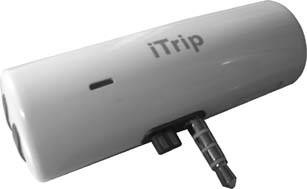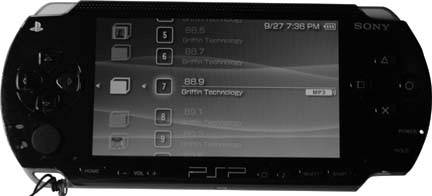Hack19.Turn Your PSP into a Radio Station
Hack 19. Turn Your PSP into a Radio Station
What happens when a PSP and Griffin's iTrip get together? The iTrip is an FM transmitter designed for the iPod. It allows you to listen to your iPod via an FM radio (87.9 MHz to 107.9 MHz). There is a good reason for using the iTrip instead of a normal FM transmitter that plugs into the headphone jack. A standard FM transmitter uses switches or a large LCD screen to change frequencies, whereas the iTrip uses digital tones played by the PSP's MP3 player to change the output frequencies. Therefore, with no switches or LCD screens, the circuit board is very small and doesn't get in your way. To make this work, you're going to need to gut the iTrip (see Figure 2-53) and fuse it into your PSP. Removal of the iTrip's circuitry is simple: take an Xacto blade and separate the two plastic halves that sandwich the circuit board between them, as shown in Figure 2-54. 2.9.1. Making It WorkThis hack involves disassembly of your Sony PSP [Hack #8]. Use your digital camera to take many photos throughout this process so that you can refer to them later. After disassembling the PSP, put the iTrip transmitter between the outer case and audio/WiFi card (you'll recognize this card when you see that the headphone jack is fixed to it). This is an ideal place for it, because it is near the audio points that you have to solder wires to. Figure 2-53. iTrip Figure 2-54. iTrip removed from its casing compared to the PSP's battery The iTrip was never intended to be placed inside of a Japanese handheld gaming console, so you'll need to make some adjustments. With the iTrip in place, you'll see that the crystal oscillator (a subcomponent of the iTrip used to define the frequency range of the transmitter) will not fit. Using a handheld rotary drill (a Dremel, for example), make an oscillator-shaped hole in the back side of the plastic casingthe oscillator will fit into the hole to allow clearance. The iTrip has a basic wiring setup. All it needs is +3 volts DC, ground, and an audio signal to turn it on. All of these voltages and audio signals can be found inside the handheld (see Figure 2-55 for the pinout). The audio signal used for playing MP3s, games, and movies is the same one used for playing unique tones to select the iTrip's frequency. Because the iTrip has an audio sensing circuit to turn itself on (a battery-saving feature for the iPod), a dummy headphone plug that connects to nothing will turn on the transmitter when you need it. With no dummy headphone plug inserted, the PSP is in normal operation. Figure 2-55. Pinout from PSP to iTrip 2.9.2. Finding PowerThe PSP runs off of a 3.6-volt DC battery, which is perfect for powering the iTrip. Figure 2-56 shows the locations of the voltage points on the main board. 2.9.3. Reassembling and Final StepsNow it's time to put it all back together [Hack #9]. The only deviation from the "Reassemble Hack" is a grounding plate that's discarded to make a better fit. This should not affect the PSP in any way. The last thing to do is to load the audio files that will allow the iTrip to change frequencies. Insert your iTrip CD into your computer. Go to the \Setup\US folder (this will vary based on which country you live in; for example, it will be \Setup\JP if you live in Japan) and copy these files to a folder in your music directory on the PSP. You could label it "Change Freqs" or whatever is convenient for you. 2.9.4. Using the PSP's Interface to Change FrequenciesThis hack would not be interesting if it involved pressing buttons to change frequencies. You can now impress your friends by demonstrating that you can transmit your music on any FM channel you choose. Simply go to the PSP's own user interface and select the audio player. Then go to the folder you labeled "Change Freqs." Scroll through the 100+ frequencies you have at your disposal, as shown in Figure 2-57, and select one. The unique digital tone will play for five seconds. After it has played that tone, pause the player, because the PSP's player thinks these files are songs and will go on to the next file. If you let it play without stopping, it will change your frequency from 99.5 MHz to 99.7 MHz, and so on. Once the frequency is set, go back to your game, movie, or MP3s, and enjoy listening to your PSP on your home theater or in the car on your way to work. Figure 2-56. The left wire is +3 volts, and the right wire is ground 2.9.5. Hacking the HackIn order to comply with the FCC's rules on interfering with other consumer electronics, the iTrip is set to transmit at a low level. You can de-solder the equipped antenna and solder in a small RF connector. A pigtail could connect the iTrip to an external antenna or RF amplifier for better range, as long as it stayed within the guidelines set out by the FCC. And, if not, you could always look into a Low Power FM (http://www.fcc.gov/mb/audio/lpfm/) license! David Julian Figure 2-57. Audio files to change frequency accessed through PSP's music player |
EAN: 2147483647
Pages: 108